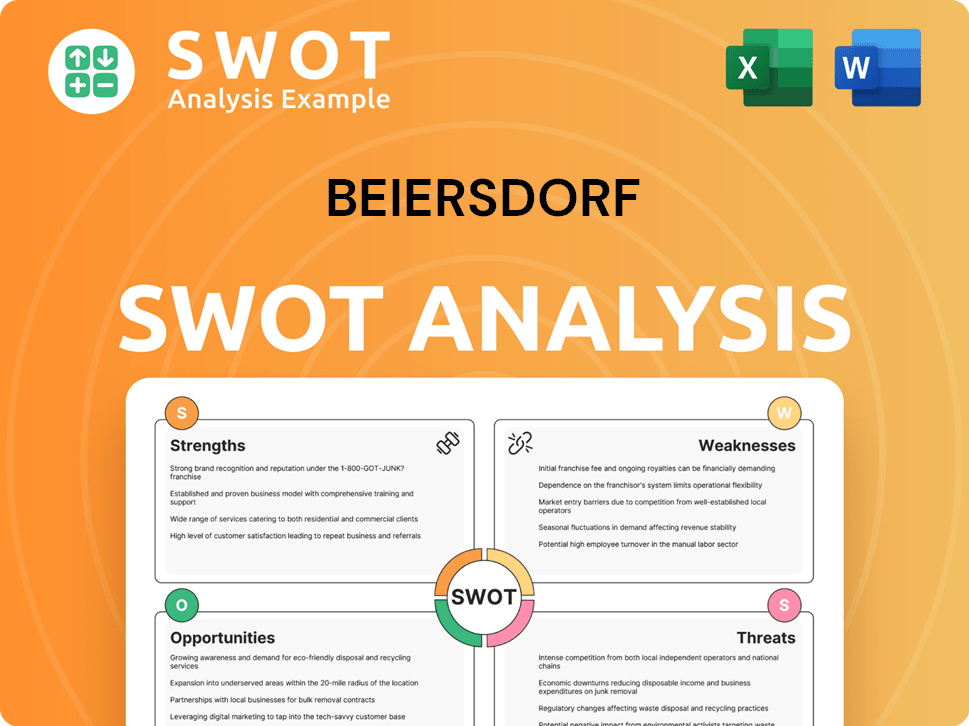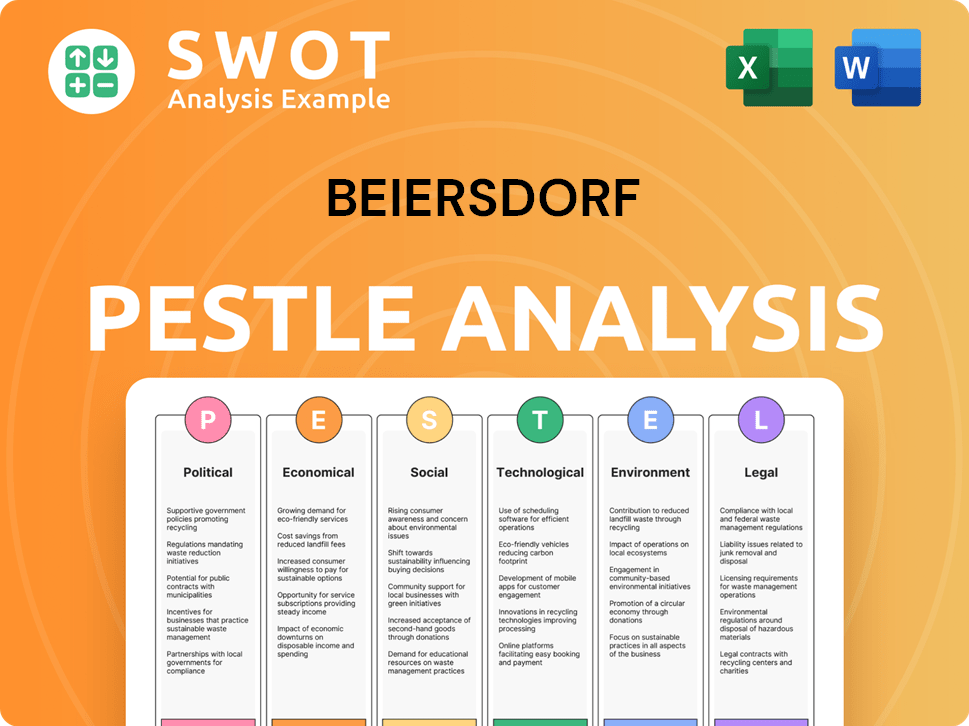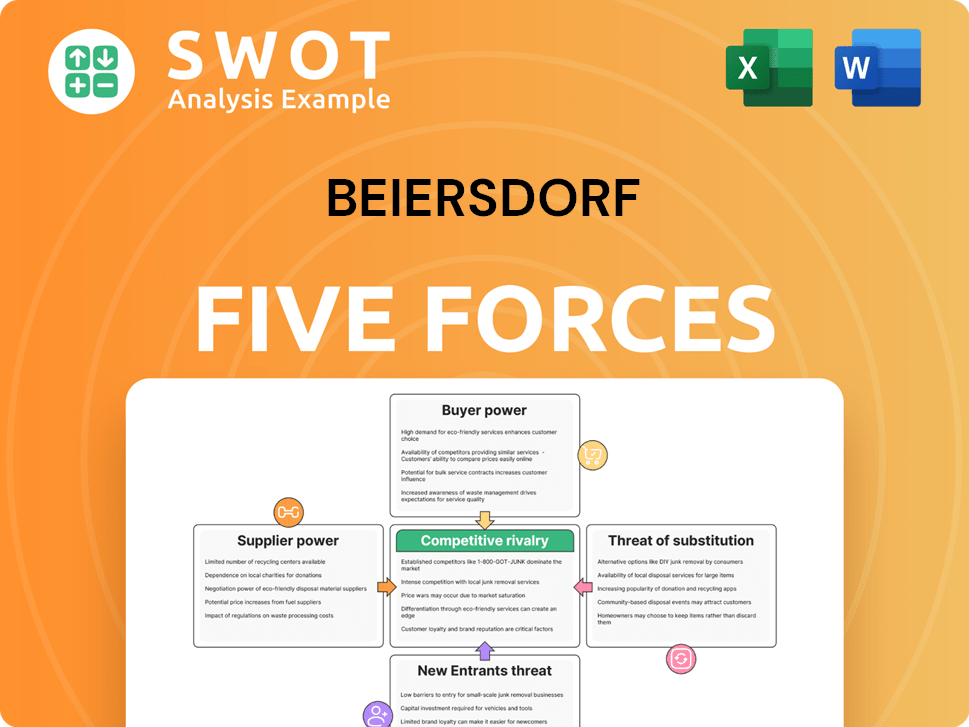Beiersdorf Bundle
Decoding Beiersdorf: Who Buys Their Products?
From the iconic Beiersdorf SWOT Analysis to everyday skincare essentials, Beiersdorf's products are globally recognized. But have you ever wondered about the people behind the purchases? Understanding the customer demographics and target market of the Beiersdorf company is key to grasping its enduring success in the competitive personal care industry. This exploration delves into the core of Beiersdorf's business strategy.

This analysis will uncover the market segmentation strategies employed by Beiersdorf, examining the consumer profile of its diverse customer base. We will explore questions like "Who is the target audience for Nivea products?" and "What are the demographics of Nivea consumers?" to provide a comprehensive understanding of Beiersdorf's market positioning. Furthermore, we will investigate Beiersdorf's customer demographics by age and gender, as well as its specific target market for skincare and sun care products, and where does Beiersdorf sell its products.
Who Are Beiersdorf’s Main Customers?
Understanding the customer demographics and target market of the Beiersdorf company is crucial for grasping its market position. The company primarily focuses on the consumer market (B2C) through its diverse portfolio of skin and personal care brands. This approach allows it to cater to a wide range of consumer needs and preferences.
The company's strategy involves segmenting its market to effectively address different consumer groups. This market segmentation allows for tailored product offerings and marketing strategies, driving sales and brand loyalty. The consumer profile varies across its brands, reflecting the diverse needs of the target audience.
In 2023, the Consumer segment accounted for 81.3% of the company's sales, highlighting its significance. The tesa segment, which provides adhesive solutions, contributed 18.7% to the group sales in the same year. This demonstrates the company's diversified approach to its markets.
The Consumer segment includes a broad demographic, with brands like Nivea, Eucerin, La Prairie, and Hansaplast. Who is the target audience for Nivea products? Nivea appeals to a wide age range, from young adults to seniors, with products for general skincare, sun protection, and men's grooming. Eucerin targets consumers with specific dermatological concerns. La Prairie focuses on affluent consumers seeking high-end skincare.
The tesa segment has a significant B2B component, providing adhesive solutions for various industries. This segment targets businesses of varying sizes, from small enterprises to large multinational corporations. Decision-makers focus on industrial efficiency, product quality, and specialized application needs. This segment contributed 18.7% to the company's group sales in 2023.
The company has expanded its target segments beyond basic skincare. The acquisition of Chantecaille in 2022 strengthened its position in the prestige beauty market. This expansion is driven by growing demand for premium and specialized skincare. The company's emphasis on sustainability and digitalization reflects adaptation to evolving consumer preferences and online retail channels.
The key customer segments for the company include consumers of all ages and income levels, with specific focus on those seeking skincare solutions. The company's brands cater to diverse needs, from general skincare to specialized dermatological care and luxury products. Beiersdorf's target market for skincare is broad, encompassing various demographics.
Beiersdorf's customer demographics by age vary across its brands. Nivea attracts a broad age range, Eucerin targets those with specific skin concerns, and La Prairie focuses on affluent, older consumers. Beiersdorf's customer demographics gender is diverse, with products designed for both men and women. Beiersdorf's target market for sun care includes all age groups seeking sun protection.
- Nivea: Wide age range, middle-income households.
- Eucerin: Various age groups, disposable income for specialized skincare. Who buys Eucerin products? Those with specific dermatological concerns.
- La Prairie: Affluent consumers, often women aged 40+.
- Hansaplast: Universal demographic, families and individuals of all ages.
Beiersdorf SWOT Analysis
- Complete SWOT Breakdown
- Fully Customizable
- Editable in Excel & Word
- Professional Formatting
- Investor-Ready Format

What Do Beiersdorf’s Customers Want?
Understanding the customer needs and preferences is crucial for the success of the Beiersdorf company. Their customer base is diverse, with varying needs that range from practical skincare solutions to aspirational desires for luxury products. This diversity influences purchasing behaviors and product development across their portfolio of brands.
For mass-market brands like Nivea, customers seek accessible and affordable products that provide reliable daily skincare. Specialized brands such as Eucerin cater to those with specific dermatological conditions, while La Prairie targets customers looking for luxury and anti-aging benefits. These differences drive the company's market segmentation and product strategies.
Beiersdorf addresses common customer pain points through product innovation and targeted marketing. The company is also responding to the growing demand for sustainable and ethical products, as seen in their initiatives like the climate-neutralized Nivea product range launched in 2024. This approach helps Beiersdorf maintain its relevance and meet the evolving needs of its diverse customer base.
Customers of Nivea often prioritize accessibility, affordability, and brand familiarity. They seek reliable daily skincare solutions for hydration, sun protection, and gentle care. The psychological driver is often a sense of trust and comfort.
Eucerin customers have more specific needs, often related to dermatological conditions. Purchasing decisions are influenced by product formulations, clinical efficacy, and dermatologist recommendations. They prioritize scientific backing and research.
La Prairie customers are motivated by aspirational drivers, seeking luxurious experiences and anti-aging benefits. Their purchasing behaviors are influenced by brand prestige, premium ingredients, and the overall sensory experience.
For Nivea, key criteria include product efficacy, scent, texture, and value for money. Eucerin customers focus on product formulations and clinical results. La Prairie customers consider brand prestige and visible results.
Nivea's campaigns often emphasize family and everyday care. La Prairie's marketing focuses on luxury, scientific advancement, and exclusivity, often through high-end digital and print media.
Beiersdorf is investing in sustainable packaging solutions, such as NIVEA's first climate-neutralized product range launched in 2024. The company aims to reduce fossil-based virgin plastic by 50% by 2025.
Analyzing the consumer behavior of Beiersdorf company reveals distinct patterns across its brand portfolio. The target market for Nivea, for example, includes a broad demographic seeking affordable and accessible skincare solutions, while Eucerin targets consumers with specific dermatological needs. La Prairie focuses on a luxury segment.
- Market Segmentation: Beiersdorf employs market segmentation to cater to various customer needs, from mass-market to luxury segments.
- Consumer Profile: Understanding the consumer profile is critical for tailoring product development and marketing strategies.
- Product Innovation: Continuous product innovation addresses common pain points such as sensitive skin and signs of aging.
- Sustainability: The company is investing in sustainable packaging and reducing its environmental impact. For example, in 2023, Beiersdorf reported that 70% of its packaging was already recyclable or reusable.
Beiersdorf PESTLE Analysis
- Covers All 6 PESTLE Categories
- No Research Needed – Save Hours of Work
- Built by Experts, Trusted by Consultants
- Instant Download, Ready to Use
- 100% Editable, Fully Customizable

Where does Beiersdorf operate?
The Beiersdorf company maintains a significant global presence, with operations spanning across Europe, the Americas, Asia, and Africa. This widespread geographical reach is crucial for understanding its diverse customer demographics and tailoring its products to meet regional needs. The company's success is heavily reliant on its ability to adapt to various market conditions and consumer preferences worldwide. Beiersdorf's strategic focus on both established and emerging markets underscores its commitment to sustainable growth.
Europe, the Americas, and Asia-Africa-Australia are the main regions where the company operates. Each region contributes significantly to the company's overall sales, reflecting a balanced global approach. The company's ability to navigate different cultural and economic landscapes is a key factor in its continued success. Understanding the nuances of each market allows the company to effectively target its products and marketing efforts.
The Beiersdorf company's geographical market presence is a testament to its strategic vision and operational capabilities. It showcases a commitment to understanding and serving diverse customer needs across the globe. For a deeper dive into the company's origins and evolution, you can explore the Brief History of Beiersdorf.
Europe is a core market for the company, particularly Germany. In 2023, Europe accounted for 43.6% of the company's Consumer business sales. Strong brand recognition and market share in both Western and Eastern Europe contribute to this dominance.
The Americas, including North and Latin America, represent a significant market. The United States is a key market for brands like Eucerin and Aquaphor. In 2023, the Americas contributed 28.3% to Consumer business sales.
Asia, especially China and other emerging markets, is a major growth driver. The Africa/Asia/Australia region accounted for 28.1% of Consumer business sales in 2023. This growth is fueled by an expanding middle class and increasing demand.
Localized strategies are essential due to differences in customer demographics, preferences, and buying power. Product formulations, packaging, and marketing messages are adapted to suit local cultural nuances and economic conditions. Regional R&D centers help tailor offerings.
The company adapts its products and marketing to suit local needs. This includes adjusting product formulations, packaging sizes, and marketing messages to align with regional preferences and economic conditions. This approach helps the company to effectively target its target market.
- Skin-lightening products are in demand in some Asian markets.
- Anti-aging and sun protection products are crucial in Western markets.
- Regional R&D centers and local partnerships are used to understand market needs.
- Recent expansions focus on emerging markets.
Beiersdorf Business Model Canvas
- Complete 9-Block Business Model Canvas
- Effortlessly Communicate Your Business Strategy
- Investor-Ready BMC Format
- 100% Editable and Customizable
- Clear and Structured Layout

How Does Beiersdorf Win & Keep Customers?
The Beiersdorf company employs a comprehensive strategy for customer acquisition and retention. This strategy involves a blend of traditional and digital marketing methods. The company focuses on understanding its customer demographics and tailoring its approach to different market segments.
Digital marketing is a key component, with an emphasis on social media, influencer collaborations, and targeted online advertising. The company uses a variety of sales tactics, including in-store promotions and personalized consultations, to engage customers. Loyalty programs are also being explored to encourage repeat purchases and brand loyalty, especially for premium products.
Customer experience is prioritized through personalized recommendations and communications, driven by customer data and CRM systems. After-sales service, including customer helplines and hassle-free return policies, is provided to ensure customer satisfaction. Furthermore, Beiersdorf emphasizes product innovation and scientific efficacy to attract and retain customers.
Beiersdorf uses digital marketing extensively, including social media campaigns, influencer collaborations, and SEO. This approach helps reach a broad audience and target specific demographics. For instance, Nivea often runs viral campaigns to connect with younger consumers.
Sales tactics vary by brand and market, including in-store promotions and personalized consultations. Loyalty programs are also used to foster repeat purchases. These strategies are designed to cater to different consumer profiles and preferences.
The company focuses on personalized customer experiences through data-driven recommendations and communications. Online quizzes and diagnostic tools are used to suggest specific products. This approach enhances customer engagement and satisfaction.
After-sales service includes customer helplines, online support, and hassle-free return policies. This support system ensures customer satisfaction, particularly for specialized or luxury products. The goal is to build lasting customer relationships.
Beiersdorf’s customer acquisition strategies are also influenced by the shift towards digitalization and sustainability. The company’s increasing focus on e-commerce and direct-to-consumer (DTC) channels enables more direct engagement with consumers. This allows for the collection of valuable data, which informs more targeted campaigns and personalized experiences. This digital transformation aims to enhance customer lifetime value and reduce churn rates by building stronger, more direct relationships with consumers. In 2024, Beiersdorf reported that its e-commerce sales grew significantly, reflecting the success of its digital initiatives.
Beiersdorf uses market segmentation to tailor marketing messages to specific demographic and psychographic groups. This ensures that campaigns resonate with the target audience. This approach helps in efficiently allocating marketing resources.
Successful acquisition campaigns often highlight product innovation and scientific efficacy. The company invests in research and development to create products that meet consumer needs. This focus on innovation helps to maintain a competitive edge.
Beiersdorf focuses on building strong brand values and emotional connections with consumers. Campaigns like Nivea's 'Care' emphasize universal values. This approach fosters loyalty and brand advocacy.
The company is increasingly investing in e-commerce and direct-to-consumer channels. This allows for more direct customer engagement and valuable data collection. This strategy enhances customer lifetime value.
Beiersdorf is integrating sustainability into its acquisition and retention strategies. This includes eco-friendly packaging and sustainable sourcing. Sustainability efforts appeal to environmentally conscious consumers.
Loyalty programs are being explored to foster repeat purchases and brand advocacy, particularly for premium segments. These programs help build long-term customer relationships. Loyalty programs can increase customer lifetime value.
Beiersdorf Porter's Five Forces Analysis
- Covers All 5 Competitive Forces in Detail
- Structured for Consultants, Students, and Founders
- 100% Editable in Microsoft Word & Excel
- Instant Digital Download – Use Immediately
- Compatible with Mac & PC – Fully Unlocked

Related Blogs
- What are Mission Vision & Core Values of Beiersdorf Company?
- What is Competitive Landscape of Beiersdorf Company?
- What is Growth Strategy and Future Prospects of Beiersdorf Company?
- How Does Beiersdorf Company Work?
- What is Sales and Marketing Strategy of Beiersdorf Company?
- What is Brief History of Beiersdorf Company?
- Who Owns Beiersdorf Company?
Disclaimer
All information, articles, and product details provided on this website are for general informational and educational purposes only. We do not claim any ownership over, nor do we intend to infringe upon, any trademarks, copyrights, logos, brand names, or other intellectual property mentioned or depicted on this site. Such intellectual property remains the property of its respective owners, and any references here are made solely for identification or informational purposes, without implying any affiliation, endorsement, or partnership.
We make no representations or warranties, express or implied, regarding the accuracy, completeness, or suitability of any content or products presented. Nothing on this website should be construed as legal, tax, investment, financial, medical, or other professional advice. In addition, no part of this site—including articles or product references—constitutes a solicitation, recommendation, endorsement, advertisement, or offer to buy or sell any securities, franchises, or other financial instruments, particularly in jurisdictions where such activity would be unlawful.
All content is of a general nature and may not address the specific circumstances of any individual or entity. It is not a substitute for professional advice or services. Any actions you take based on the information provided here are strictly at your own risk. You accept full responsibility for any decisions or outcomes arising from your use of this website and agree to release us from any liability in connection with your use of, or reliance upon, the content or products found herein.